Fuel System -- Precaution |
| 1.PRECAUTION |
Before inspecting and repairing the fuel system, disconnect the cable from the negative battery terminal.
Do not smoke or work near fire when handling the fuel system.
Keep gasoline away from rubber or leather parts.
| 2.DISCHARGE FUEL SYSTEM PRESSURE |
- CAUTION:
- Perform the following procedures to prevent fuel from spilling out before removing any fuel system parts.
- Pressure will still remain in the fuel line even after performing the following procedures. When disconnecting the fuel line, cover it with a shop rag or a piece of cloth to prevent fuel from spraying or coming out.
Remove the rear seat cushion assembly.
Remove the rear floor service hole cover.
Disconnect the fuel pump connector.
Start the engine.
After the engine stops, turn the ignition switch off.
- HINT:
- DTC P0171/25 (fuel problem) may be detected.
Crank the engine again. Check that the engine does not start.
Remove the fuel tank cap to discharge pressure from the fuel tank.
Disconnect the cable from the negative battery terminal.
Reconnect the fuel pump connector.
Install the rear floor service hole cover.
Install the rear seat.
 |
| 3.FUEL SYSTEM |
When disconnecting the high fuel pressure line, a large amount of gasoline will spill out, so observe the following procedures:
Discharge the fuel system pressure (step 2).
Disconnect the fuel pump tube (CAMRY_ACV40 RM000001IRA004X_01_0005.html).
Drain the fuel that remains inside the fuel pump tube.
To protect the disconnected fuel pump tube from damage and contamination, cover it with a plastic bag.
Put a container under the connection part.

Observe the following precautions when removing and installing the fuel injectors:
Never reuse an O-ring.
When placing a new O-ring on the injector, do not damage the O-ring.
Coat a new O-ring with gasoline before installing it.
- NOTICE:
- Do not use engine oil, gear oil or brake fluid.
Install the injector to the delivery pipe and cylinder head, as shown in the illustration.
- NOTICE:
- Before installing the injector, be sure to apply grease or gasoline to the place where the delivery pipe or cylinder head contacts the O-ring of the injector.
Observe the following precautions when disconnecting the fuel delivery pipe (metallic type):
- HINT:
- The structure of the metallic connector is shown on the left.
Remove the No. 2 fuel pipe clamp.
- HINT:
- The No. 2 fuel pipe clamp cannot be reused.
Find the metallic connector of the fuel tube assembly.
Assemble SST to the connection as shown in the illustration.
- SST
- 09268-21010
Turn the SST, align the retainers inside the connector with the SST chamfered parts and insert SST into the connector.
Slide the SST and the connector together towards the fuel tube assembly.
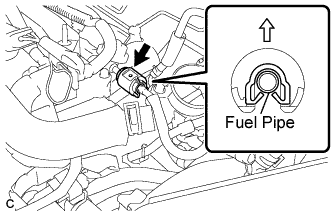
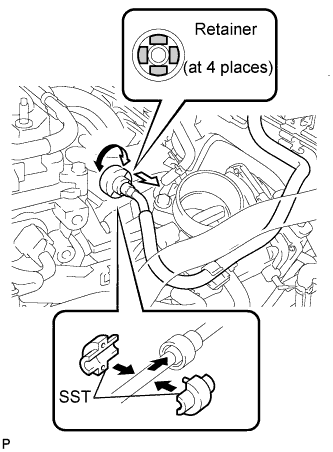
Observe the following precautions when connecting the fuel tube connector (metallic type):
Check if there is any damage or foreign objects on the connecting part of the pipe.
Match the axis of the connector with the axis of the pipe, and push into the connector until the connector makes a "click" sound. If the connection is tight, apply a small amount of fresh engine oil to the tip of the pipe.
After finishing the connection, check if the pipe and the connector are securely connected by pulling on them.
Check for fuel leaks.
Install a new No. 2 fuel pipe clamp.
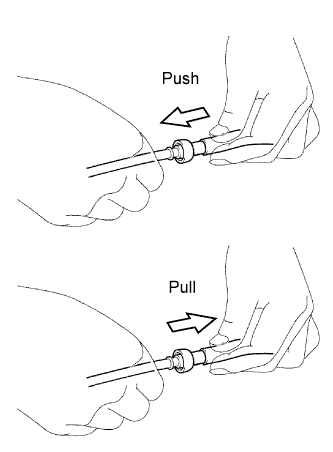
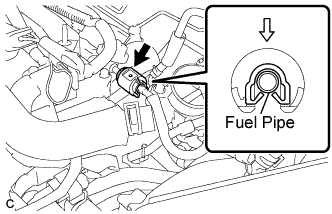
Observe the following precautions when disconnecting the fuel tube connectors (Quick type A):
Remove the No. 1 fuel pipe clamp from the tube connector.
Check that there is no dirt or other foreign objects on the pipe and around the connector before disconnecting them. Clean them if necessary.
Disconnect the connector from the pipe by hand.
When the connector and the pipe are stuck, push in and pull on the connector to release it. Pull the connector out of the pipe carefully.
Check that there is no dirt or other foreign objects on the sealing surface of the disconnected pipe. Clean it away if necessary.
Do not damage the disconnected pipe and connector, and prevent entry of foreign objects by covering them with plastic bags.
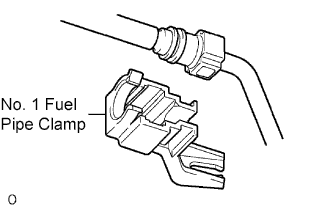

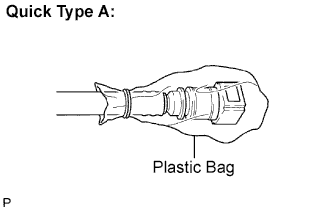
Observe the following precautions when connecting the fuel tube connectors (Quick Type A):
Check if there is any damage or foreign objects on the connecting parts of the pipes.
Line up the two parts of the pipes to be connected, and push them together until the connector makes a "click" sound. If the pipe is difficult to push into the connector, apply a small amount of clean engine oil to the tip of the pipe and reinsert it.
After connecting the pipes, check that the pipe and connector are securely connected by pulling on them.
Check for fuel leaks.
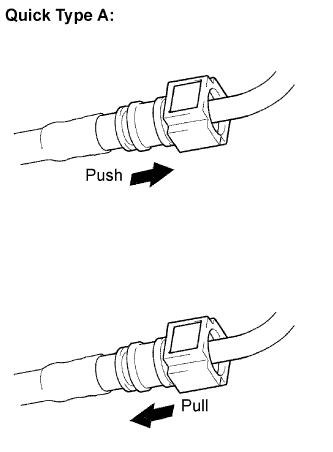
Observe the following precautions when disconnecting the fuel tube connector (Quick type B):
Before disconnecting the connector, clean off any dirt that may be present.
Pinch the tabs of the fuel tube retainer to disengage the 2 claws. Push the retainer down as shown in the illustration.
- HINT:
- Be sure to disconnect the connector by hand.
If the connector and pipe are stuck, hold the fuel pipe by hand and push and pull on the connector. Pull the two pipes apart to separate the connector.
If there is any dirt or any other foreign objects on the sealing surfaces of the disconnected pipes, clean them if necessary.
Do not damage the disconnected pipe and connector, and prevent entry of foreign objects by covering them with plastic bags.
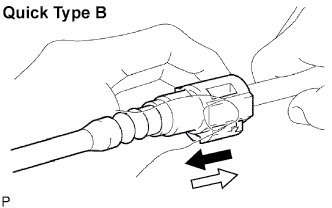

Observe the following precautions when connecting the fuel tube connector (Quick Type B):
Line up the two parts of the pipes to be connected, and fully push the fuel tube connector and pipe together until they are fully seated. Next, push the retainer into the connector until its claws lock. If the pipe is difficult to push in to the connector, apply a small amount of clean engine oil to the tip of the pipe and reinsert it.
After connecting the pipes, check that the pipe and connector are securely connected by pulling on them.
Check for fuel leaks.

Observe the following precautions when handling a nylon tube:
- CAUTION:
- Do not twist the connection part of the nylon tube and the quick connector when connecting them.
- Do not bend or twist the nylon tube.
- Do not remove the EPDM protector on the outside of the nylon tube.
- Do not close the piping by bending the nylon tube.
 |
 |
 |
 |
| 4.CHECK FOR FUEL LEAKS |
Check that there are no fuel leaks from the fuel system after doing any maintenance or repairs (CAMRY_ACV40 RM000000YCR003X.html).